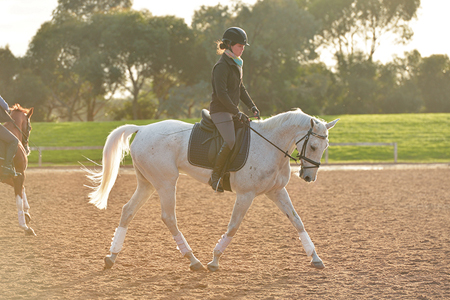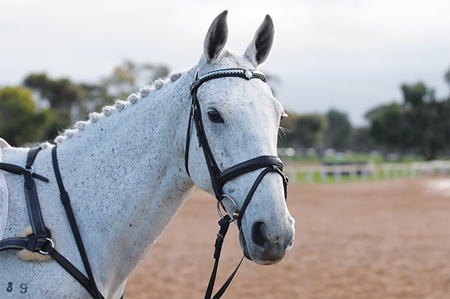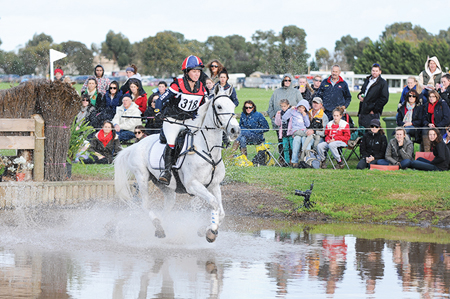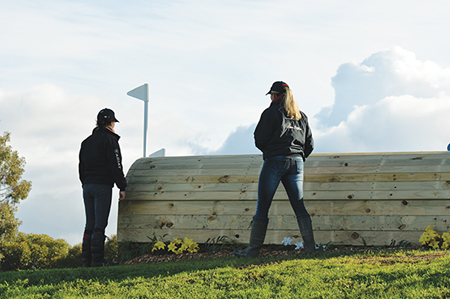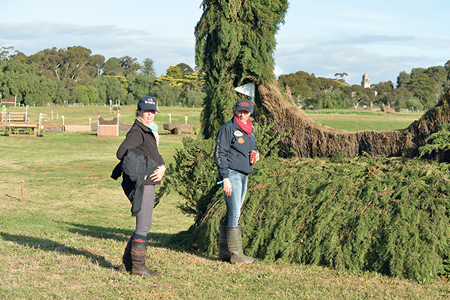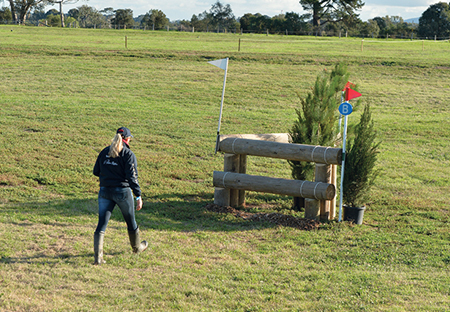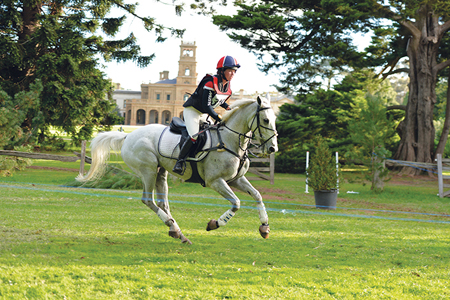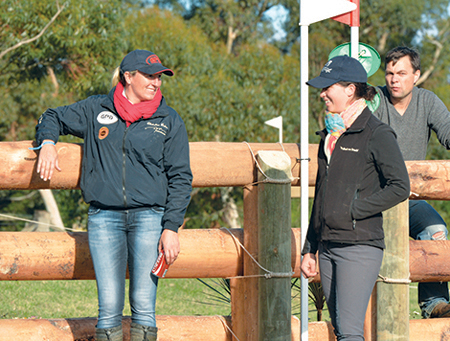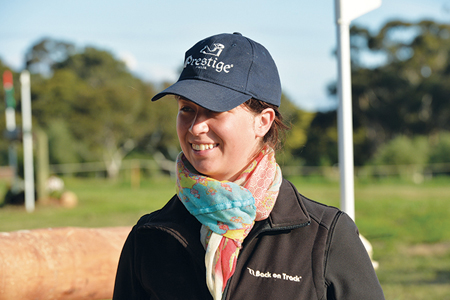In the first part of the series Jess and Christine told us how they worked on Legal Star’s dressage and the tricks they used to create event atmosphere at home to prepare for next competition. Now the time has come; it is the weekend of the Melbourne International Horse Trials and THM catches up again with Jess, Christine and Legal Star aka Trumby.
So what has happened since our last meeting?
“We have been working very hard on the dressage in the last two weeks leading up to Melbourne,” Christine explains.
“Every day he has improved a little bit more. We also went for some gallops and jump sessions and then last week Jess had squad training with Brett Parbery and Rod Brown. I don’t think there is anything else we could have done in the preparation.”
“Now it is about keeping him happy and relaxed. So this morning (Friday) Jess gave him a gallop and a jump session. We do arena familiarisation and a dressage lesson this afternoon. On Saturday we will walk the course and measure the track. Her dressage test is in the afternoon, so depending on how the horse feels and how he is going, we will have one or two dressage lessons in the morning. With Trumby it is really about having the rideability and making sure that he is schooling all the movements well. It’s that balance of keeping him tuned enough and happy enough.”
For the first time in years, the 3 and 2 Star dressage will be held outside at Werribee. The new arena for the dressage and showjumping is set up on the polo fields, surrounded by tiered grandstands, a two-storey VIP marquee, a video screen, a boom lift (note by the author: this is important), judges’ boxes, colourful banners and a white picket fence – in other words, there is lots happening. Would Christine and Jess have preferred to have the dressage in the indoor arena?
Christine tells us, “Every other event is run outside, so personally I would rather be outside. In saying that the new arena on the polo field is pretty spooky. There were a lot of tense horses in the 2 Star. This afternoon we will work him as close to the competition arena as possible, so he doesn’t think that being over here is a big deal.”
Come Friday afternoon Jess uses her time for arena familiarisation wisely, taking Trumby around the competition and the warm-up arena past all the hidden tigers. Trumby is very cool and relaxed and does not seem fazed. Having said that, it is late afternoon, the day’s competition has finished, most people have gone home and Werribee is a very quiet place.
Christine gives Jess a dressage lesson on the big sand arena adjacent to the competition arena. A good lesson should never be rushed and the pair are working on making Trumby as supple as possible before attempting any test movements. Christine has them trotting on ten and twenty-metre circles, incorporating plenty of shoulder-in as well travers and leg-yield on curved and straight lines.
“A little shoulder-in and then straight again. Work the inside flexion and the roundness as you send him forward. Now collect him a little, shoulder in, now go forward again.”
The same applies to the canter work, twenty-metre circles and lateral movements. “A little outside bend in the canter. Now change to counter canter. Work the bend in the counter canter. Leg-yield across the diagonal, but make sure that you have the shoulders leading, not the hindquarters.”
The CCI 3 Star test requires medium and extended trot and Jess picks a diagonal to send Trumby forward. Christine corrects; “Don’t get in front of him with your upper body in the medium trot. Keep the rein contact even. Stay tall. Don’t ask for too much in the medium trot so you don’t lose the rhythm and he skips.”
Trumby has three good paces, but he is not an extravagant mover. If pushed too much in the extended trot, he is likely to lose regularity, so Christine works on Jess triding a very accurate and consistent test.
The trio are back for two further short flatwork sessions on Saturday morning. My dressage brain is concerned that the amount of work will leave Trumby too tired for the actual test, but Christine tells me not to worry.
“The idea is that we keep bringing him out here, doing short sessions and keeping him relaxed and chilled. This morning when we rode him there weren’t many people out here riding and there wasn’t much atmosphere. So I wanted to bring him out again. Also, now the wind has picked up and it is likely that it will be windy during the test in the afternoon. Each ride he has become better, hopefully when we come back for the test, he will be spot on.”
“Normally you probably wouldn’t do quite so much, but he is very fit, he is predominantly Thoroughbred and as tough as nails. He hasn’t had a run since Sydney, so he is ready to run.”
Cross Country Course Walk
Ready to run he will need to be I find out as I join Christine and Jess for a course walk over parts of the 5.7km cross-country track. Even though Jess is an experienced rider, she will walk the course several times with her coach Christine over the weekend. Christine points out some of the tricky fences that may cause issues come cross-country day.
Our first stop is at the Horseland H2O (Fence 5AB). Jess explains that this combination is not as straightforward as it looks. “The first water is pretty early on, it is the first test. It is quite a big jump in, but in saying that it is also quite friendly. As long as you get a nice jump in and have three strides to the B element, the duck, it should come up quite nice. Trumby is pretty good with water, it is just a matter of getting a nice distance to the first fence.“
Christine adds, “Our only concern with him is that with big nice jumping fences, he is such a brave bold horse, he goes on a mission and becomes too strong. The jump-in here is pretty forgiving, but the next fence is a bounce. So Jess needs to keep him under control and on the leg early on as there are lots of combinations throughout the course.”
Christine has ridden the Werribee course many times before, winning with Masterprint in 1999. What does she think about the course this year?
“I like the course, I like the changes they have made and the course designer, Ewan Kellett has done a good job. The fences are consistently up to height. It is a little more of an attacking course, as a rider that’s how I like to ride it – keep coming at the fences. The course is quite long and there are combinations right up to the second last fence. There are three big combinations towards the end of the course, so you have to ensure that you haven’t run your horse too hard at the start and have plenty of jump and rideability left at the end.”
We walk on the next challenge, the innocently named Little Rise (Fence 6AB), which certainly doesn’t look little to me.
Christine shows how to best approach this fence, “The bounce consists of roll tops, it walks a little short, but you are coming up quite a steep rise to it which will wash up a bit of pace and you will lose power in your jump. It will work for a horse like Trumby because he is quite a big jumper and for a little horse he takes a big stride. Jess will have to be careful here not to have him too strong and jumping too big. It is quite short but also quite friendly because of the roll tops and if you make a mistake you should survive.”
“The two roll tops are on an angle though, so you really need the horses to hold their line and you certainly don’t want them drifting. Going to the left will give you more room, whereas going to the right will shorten it up. It is a decent test and a good raincheck for the rider – with the more technical fences coming up you really want to know whether your horse is straight and holding its line.”
Jess has already picked the flowers used for dressing the fences as her visual markers.
“The plan is to jump from the white flowers at the first one and the yellow flowers at the second one, so from the middle to the middle. The bounce is on a mound and on an angle; it is not something that we have done very often in training.
Her coach points out another important factor, “From a riding point of view you have to remember that your horse is not really going to see that second element until they take off. So the horse has to be brave and trusting of you to be ready to bounce. It has a bit of a shock factor.”
“At this level though the horses should be on the job. Hopefully you have given them a really nice ride through the water, they are listening to you and trusting you. This is a good little wake-up call.”
With these words in mind we move on to the Logan Floats Billabong (Fence 8AB), another combination consisting of a keyhole jump through a hedge, followed by a short but steep decline and then a right hand turn to an impressive looking apex. Another moment I am glad to be a dressage rider.
Christine confirms that this is indeed one of the big questions of the course. “The keyhole is a brave, big jumping fence and then you have a curving line to a skinny open-ended apex – an accuracy fence. There are two ways to jump this: you can either jump the keyhole quite straight and then do a curving five strides or put a slight angle on the keyhole and do a more direct four. It will come down to which alternative takes longer, which line we think is best for Trumby and also which is the quickest route through there. I personally like the four-stride alternative, doing the slight angle on the keyhole.”
Jess agrees. “This morning I walked the four-stride line and I was quite happy with that.”
But what happens on the day if for any reason your carefully thought-out plan doesn’t work out as you approach the fence? Christine tells us; “As a rider when you walk the course, you have plans for each fence for how you would like it to happen and for when it goes wrong. And sometimes you can come in on the approach and you change your mind. For now we will walk both lines, talk to a few other riders and look how it’s riding during the day.”
As it happened Christine was right with her prediction. The Logan Floats Billabong combination proved to be the undoing of five riders – a quarter of the 3 Star field. No problem here for Jess and Trumby however, just as planned the pair went through smoothly in four strides.
Ewan Kellett had changed the water complex in the camel paddock area as well. This year riders are coming from the Rose Garden and the Ornamental Lake to the Jurox Pond (Fence 21ABC) as one of the last fences on course. This move has turned the peaceful looking pond with its beautifully wood-carved fish in the centre into another challenge.
Christine tells me why; “Again this is all about getting your line correct at A so that you are on the correct approach for B. A is very tall, it is an open vertical made of rails. The test here is getting a good shot over this vertical, then having a balanced canter to the B element, the fish. If you have an awkward jump in over the vertical, there is a possibility of having a run-out at the fish, a skinny fence. You also have undulating ground in the approach to A. If you have a tired horse and they are a bit on the forehand, that’s where they are likely to leave a leg. The Rose Garden has similar rails to this and if your horse is not jumping well in the Rose Garden you have to be careful here.”
The C element however, the out is relatively straightforward. It is a nice five strides from B. From then on horses and riders will be on the home stretch; the last combination is the Southern Cross Austereo Mound Muddle (Fence 22AB). Christine and Jess walk the distance between the two elements and are confident with this last challenge. Does the Melbourne 3 Star track appear more difficult than the Sydney course?
Jess says it’s hard to compare the two events. “There are very different courses. Sydney has undulating hills, which play a really big part on the toughness of the course. Here in Melbourne there are a lot of combinations, big verticals that will still test the fitness of the horse.”
Trumby is a great cross-country horse though, as Christine points out, “If it’s in front of him, he’ll jump it. Get his eye on the fence.”
Epilogue – How it turned out
Jess and Trumby had a great start to their dressage test on Saturday afternoon. Trumby was moving beautifully, well on the way to a personal best score, when the unthinkable happened. The boom lift, previously tucked away neatly next to the judges boxes, was then fully erected and had a cameraman standing on its platform. When the cameraman moved his hand, Trumby decided that that was way too scary and spun around. The pair lost connection and the score reflects the rest of the test, 19th place and 64.2 penalties.
Come cross-country day, Trumby was back in his element, doing what he does best. The pair did a brilliant round, clear with 10.8 time faults and moved up into 10th place.
They completed the event with a decent showjumping round, no rails down but some time faults and eighth place overall. Not quite what they were hoping for, but a respectable result in a top field of experienced riders such as Shane Rose and Sonja Johnson. The sport of eventing can sometimes be a cruel education.
Time for a de-brief with the coach after the event.
Christine is rather pragmatic. “At such a young age she’s had some very good success. She had a great performance in Sydney, but in Melbourne it didn’t quite come off. But for me, she has put in another solid performance. She is adding to her experience level, and she will be going away from this event having learnt a lot.”
“The horse was a little bit naughty in the dressage, but the work the horse did do was much improved. That was a reflection in her score too. In Sydney, he didn’t do anything wrong, but he didn’t do anything fancy and he was on 61 penalties. Yet, he was quite naughty in Melbourne, he really disrupted four or five movements and was on a score of 64. The judges marked him well on what he did well. I think there is still a lot of improvement with this horse on the flat. And that will come with experience on Jess’ part. She will learn to have the tools to react in a better way when he is tense. The horse has to be more on the aids. The atmosphere plays a part in his test, and they both need to be focussed. She has learnt a lot from this dressage test and she put in a great performance in the cross-country.”
“Everything rode to plan, but she said she didn’t have a great distance to the last water in the camel paddock. She couldn’t actually see the top rail, as she was riding directly into the sunlight. So she got too deep to the vertical and said that Trumby saved her bacon. Sometimes these horses have to! Jess and Trumby have a great partnership. The horse is only 12, and he might be little but he has a big heart. I still think there are big things to come from both of them.”
What is the plan from now?
“Trumby will have a break now, after his trip over from WA, he went around Sydney, now the Melbourne event as well. He will have a month off, and then we will bring him back in and really focus on his dressage. We will take him to some dressage days and I even suggested to Jess, that I might hop on him and ride him in the ring at a few local dressage days to get a feel. It can be very hard, because they have been together for so long, she has had him since she was a kid. The horse has a few tricks up his sleeve too. From a coaching point of view, I would like to know and feel what is actually going on in the ring. Then I can give her a better guide of where we are going in our training and preparation for Adelaide.”
The Adelaide 4 Star in November is the goal?
“Absolutely. I think the more events Jess can do on this horse, the more knowledge and experience she will get. She is a very good cross-country rider, she has a very good cross country horse and I just think that at that age, you cannot do enough.”
Could we expect Jess at Badminton Horse Trials one day?
“Well, we certainly have discussed that. That’s probably what we would like to aim him at in the future. If he stays fit and sound, that’s what she should try and do.”

